Platinum Supply by Region
 Sperrylite (platinum arsenide, PtAs2) ore is a major source of this metal.
Sperrylite (platinum arsenide, PtAs2) ore is a major source of this metal.
A naturally occurring platinum-iridium alloy, platiniridium, is found in the mineral cooperite (platinum sulfide, PtS).
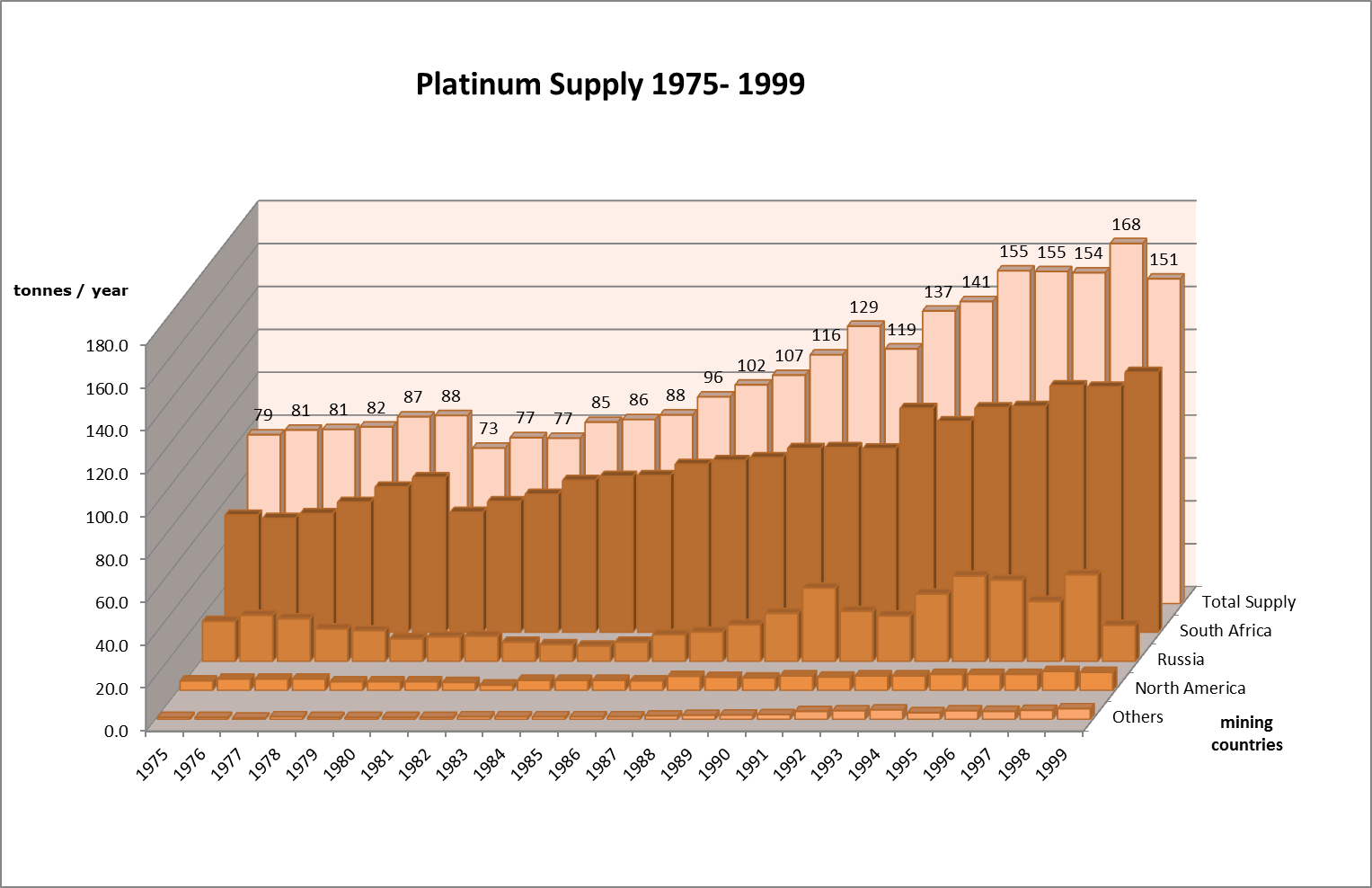
Platinum in a native state, often accompanied by small amounts of other platinum metals, is found in alluvial and placer deposits in Colombia, Ontario, the Ural Mountains, and in certain western American states. Platinum is also produced commercially as a by-product of nickel ore processing. The huge quantities of nickel ore processed makes up for the fact that platinum makes up only two parts per million of the ore.
South Africa, with vast platinum ore deposits in the Merensky Reef of the Bushveld complex, is the world's largest producer of platinum, followed by Russia.[i] [ii] Platinum and palladium are also mined commercially from the Stillwater igneous complex in Montana, USA.
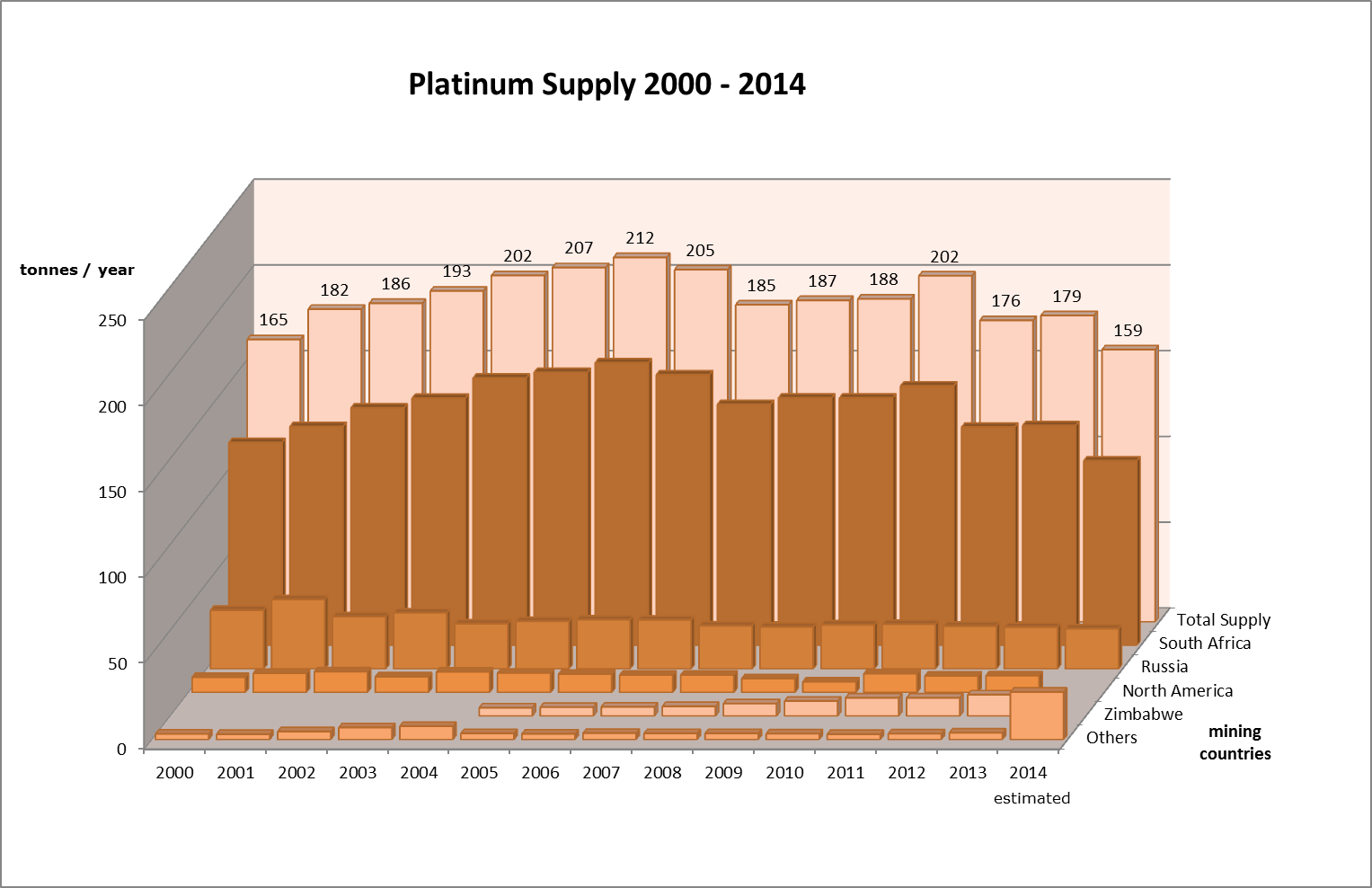

|
All data shown is extracted from databank of Johnson Matthey under www.pgmdatabase.com |
Rhodium Supply by Region
 The industrial extraction of rhodium is complex, because it occurs in ores mixed with other metals such as palladium, silver, platinum, and gold.
The industrial extraction of rhodium is complex, because it occurs in ores mixed with other metals such as palladium, silver, platinum, and gold.
It is found in platinum ores and obtained free as a white inert metal which is very difficult to fuse.
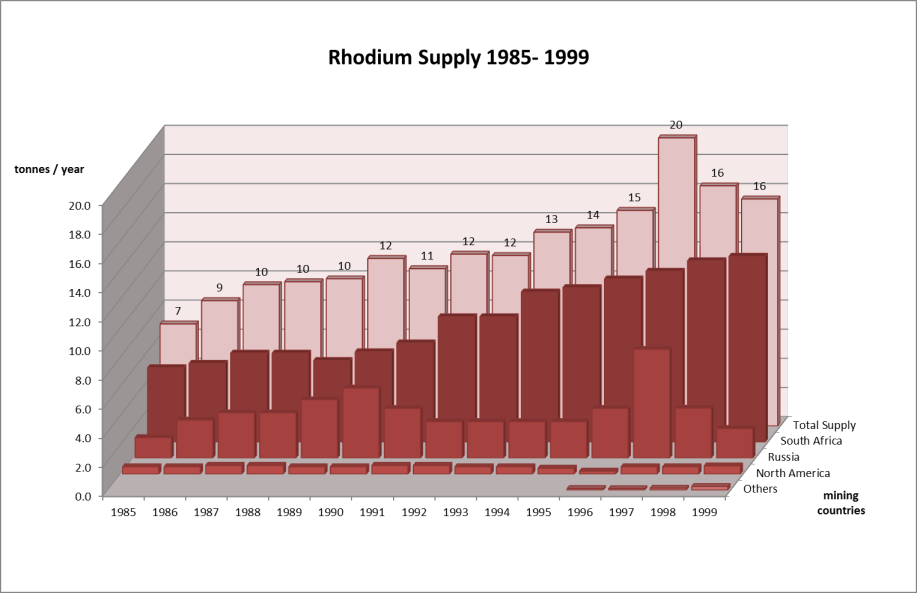
Principal sources of this element are located in river sands of the Ural Mountains, in North and South America and also in the copper-nickel sulphide mining area of the Sudbury Basin region. Although the quantity at Sudbury is very small, the large amount of nickel ore processed makes rhodium recovery cost effective.
However, the annual world production in the last years above 20t/y. of this element is and there are very few rhodium minerals.[iii]


|
All data shown is extracted from databank of Johnson Matthey under www.pgmdatabase.com |
Platinum & Palladium Mine Production
The analyses for the years upto 2013 has been made by Thomson-Reuters supported by Heraeus, Tanaka and Degussa.[iv]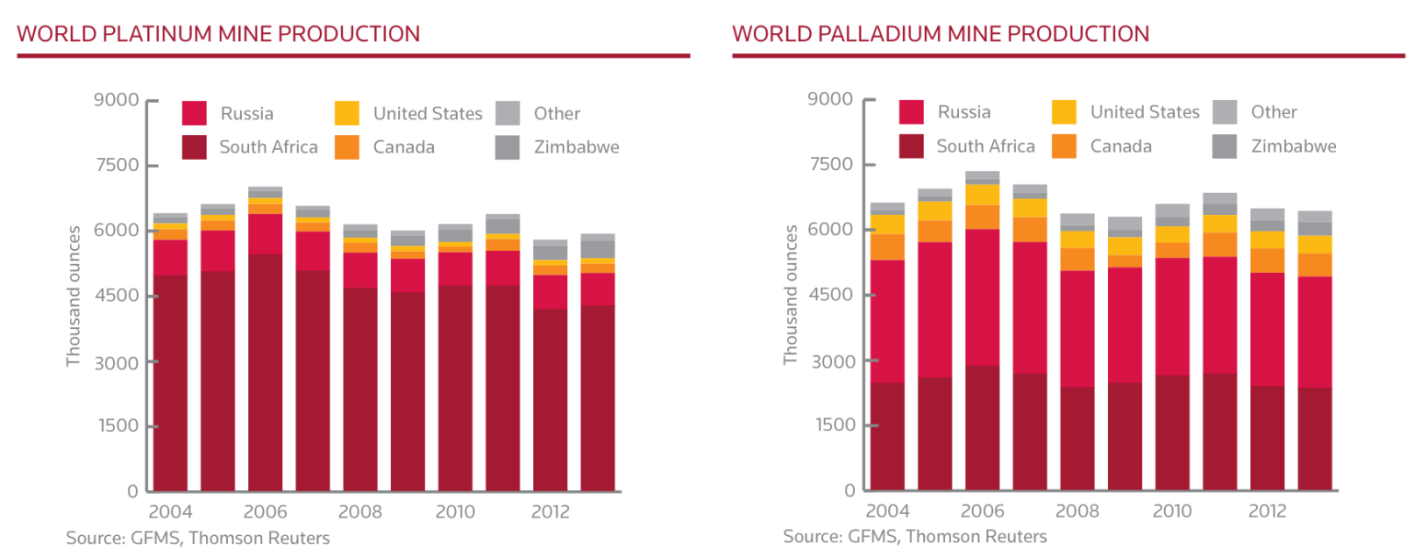
The main producer of platinum and palladium in 2013:
By comparing the regional mine production, one has to consider the scale of thousand ounces from each region.
For platinum production, South Africa is the leader. For palladium, South Africa production is the similar volume as the next following country, Russia.
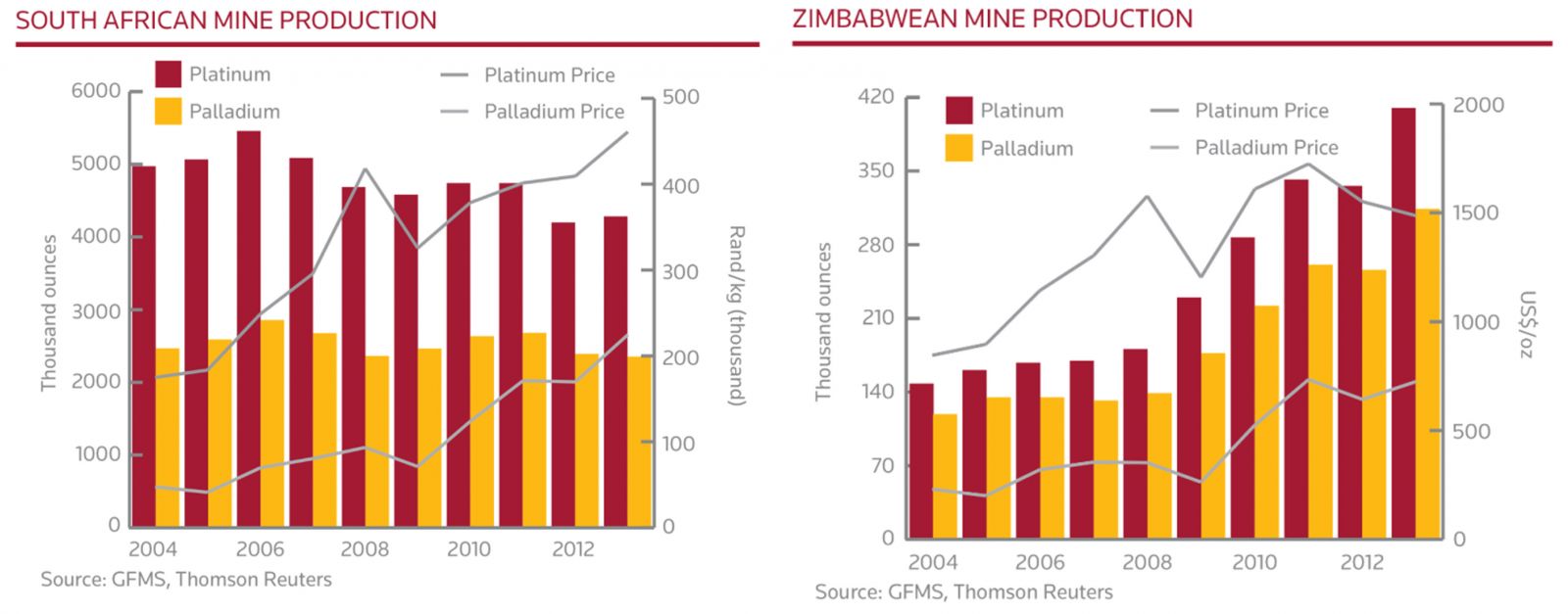




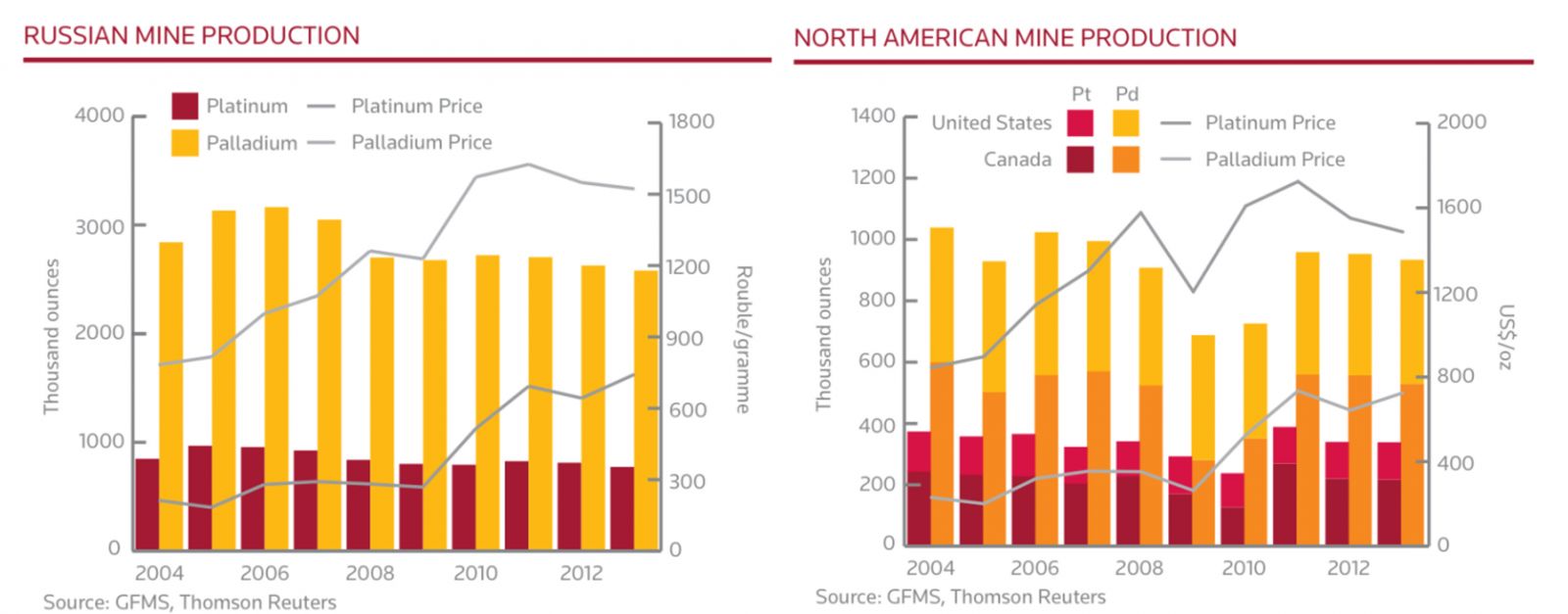
Overview worldwide
 At present most of the worldwide supply of platinum and palladium and the associated elements is obtained from mines within four major layered igneous intrusions.
At present most of the worldwide supply of platinum and palladium and the associated elements is obtained from mines within four major layered igneous intrusions.
 These are the Bushveld Complex in South Africa, the Stillwater Complex in the U.S.A., the Great Dyke in Zimbabwe, and the Noril’sk/Talnakh Complex in Russia.[v]
These are the Bushveld Complex in South Africa, the Stillwater Complex in the U.S.A., the Great Dyke in Zimbabwe, and the Noril’sk/Talnakh Complex in Russia.[v]
The Bushveld Complex is the world’s largest layered intrusion, and because of its unique character most other layered intrusions are compared with it.[vi]

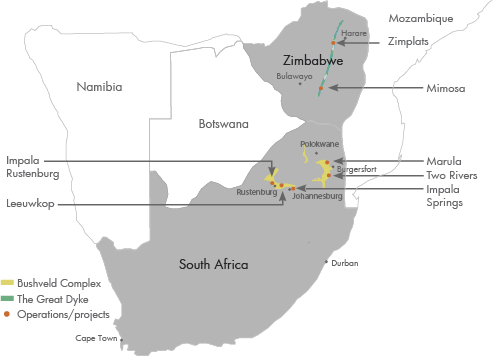
History Bushveld Complex
The PGM resources of the Bushveld Igneous Complex (BIC) were discovered by Hans Merensky and Andries Lombaard in 1924.
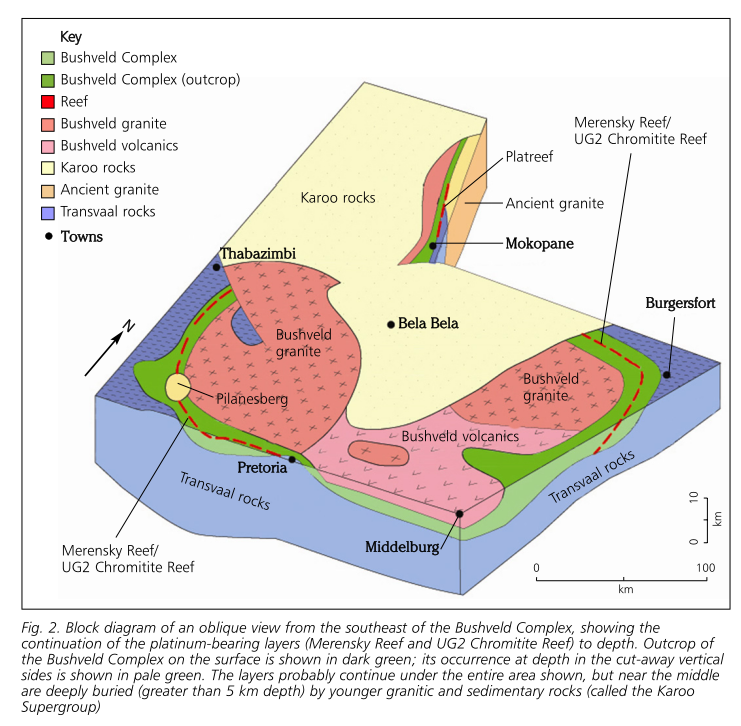
Within the complex, three horizons, the Merensky Reef, UG2 Chromitite and the Platreef are mined for PGMs and make the BIC the largest PGM resource in the world.
 Platinum and palladium production from the BIC represents approximately 75% and 40% of annual global production respectively.[vii]
Platinum and palladium production from the BIC represents approximately 75% and 40% of annual global production respectively.[vii]
Status BIC
Formed about 2,000 million years ago, the Bushveld Igneous Complex (BIC) can be compared to an enormous, irregularly-shaped saucer 370 kilometres across, with its centre buried deep underground but its rim exposed.
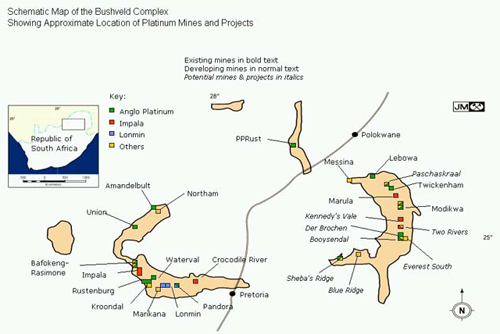
It has a series of distinct layers, three of which contain economic concentrations of platinum group metals (PGM). The principal PGM -bearing reefs are the Merensky Reef and the Upper Group 2 (UG2) Reef, which occur around the Eastern and Western sides ("limbs") of the BIC. A third PGM -rich layer, the Platreef, is found only on the Potgietersrus limb at the north-eastern edge.
The Merensky Reef was the principal source of PGM from the time that it was first worked in 1925 until the end of the 20th century. However, extraction of other reefs has grown in importance, and by 2011 the Merensky Reef accounted for only 22 per cent of all the platinum ore processed in South Africa. Exploitation of the UG2 began in the 1970s and has steadily increased; in 2011, it was the source of 63 per cent of ore processed. The Platreef, briefly mined in the 1920s, was not exploited on a large scale until 1993 but by 2011 accounted for 15 per cent of ore treated by South African platinum mines.
Mining

These layers are part of South Africa’s 2.1- billion-year-old Bushveld Complex. One 5.5-m (18-ft) thick layer in this Complex contains more than half of Earth’s known platinum reserves.[viii]

The Merensky and UG2 reefs are narrow - typically less than a metre thick. Traditionally, both reefs were mined using narrow reef methods, and many operations continue to use these methods today. Miners use hand-held pneumatic drills to bore holes which are then filled with explosive. After blasting, ore is removed from the slope using scrapers attached to winches. It is then transported through a series of ore passes to the bottom of the shaft, and hauled to the surface.
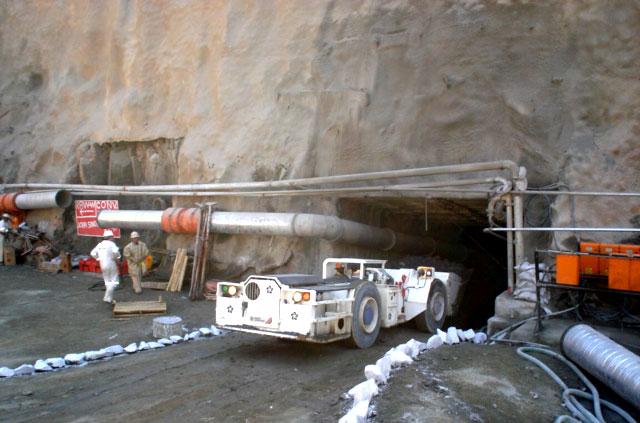 Mechanical and hybrid methods are increasingly being adopted by both new and existing mines. Drilling may be carried out either using conventional hand-held pneumatic drills, or via low-profile machines equipped with specialised drilling equipment. Ore is subsequently cleaned from the stopes using low-profile LHD (load-haul-dump) vehicles. The mining width must be greater in order to allow the use of machinery - typically around 1.8 metres.
Mechanical and hybrid methods are increasingly being adopted by both new and existing mines. Drilling may be carried out either using conventional hand-held pneumatic drills, or via low-profile machines equipped with specialised drilling equipment. Ore is subsequently cleaned from the stopes using low-profile LHD (load-haul-dump) vehicles. The mining width must be greater in order to allow the use of machinery - typically around 1.8 metres.
Open-pit methods are used to mine the Platreef, which is much wider than the other reefs, varying between 5 and 90 metres in thickness. Open casting is also used on a smaller scale to exploit the UG2 and Merensky reef where it outcrops. Mill-head grades of BIC ore (a measure of the ore's PGM content as it enters the first stage of processing) are typically between 2 and 6 grams of combined platinum, palladium, rhodium and gold per tonne. Allowing for losses which occur during refining, and the varying platinum contents of the different Bushveld ores, this means that between 10 and 40 tonnes of ore must be processed to obtain a single ounce of platinum.[ix]
Mogolokwena Platinum Mine
Mogolokwena Platinum Mine is the largest platinum mine in the world and is situated in the Northern Limb of the Bushveld Complex in South Africa.
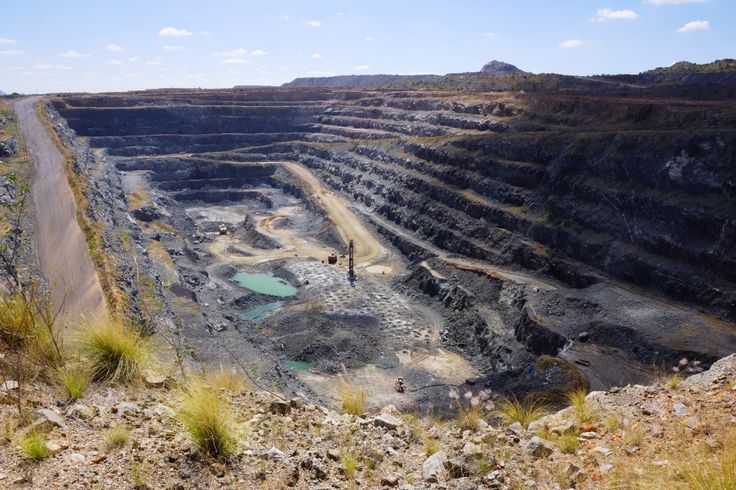
This image shows one of four open pits currently being mined by Anglo Platinum.[x]
Concentration

 The ore is crushed and milled to reduce the size of the rock particles and to expose the minerals which contain the PGM. The particles are mixed with water and special reagents and air is pumped through the liquid, creating bubbles to which the PGM-containing particles adhere.
The ore is crushed and milled to reduce the size of the rock particles and to expose the minerals which contain the PGM. The particles are mixed with water and special reagents and air is pumped through the liquid, creating bubbles to which the PGM-containing particles adhere.
These float to the surface and are removed as a soapy froth. The PGM content of this flotation concentrate varies between 100 and 1,000 grams per tonne.
After being dried, the concentrate is smelted in an electric furnace at temperatures which can exceed 1,500ºC. During this process, a matte containing the valuable metals is separated from the unwanted minerals, which form a slag and are discarded. The matte is transferred to converters, where air is blown through it in order to remove iron and sulphur. The PGM content of the "converter matte" now exceeds 1,400 grams per tonne.
Refining
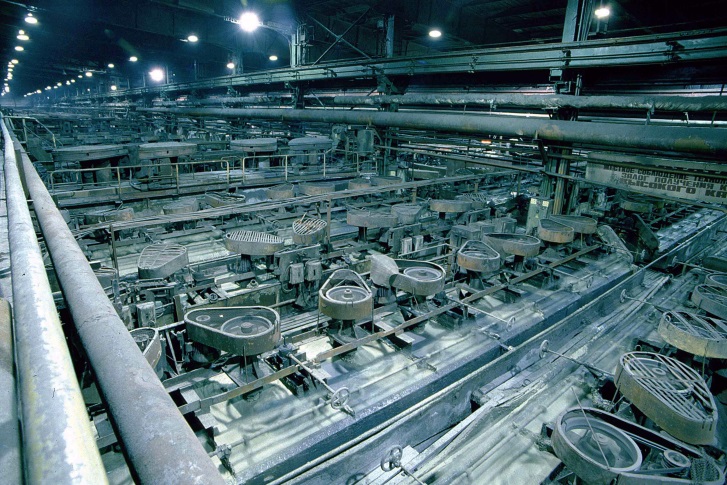
 The next step is to separate base metals from the PGM. The final stage is the separation and purification of the six PGM, plus gold and small amounts of silver. The soluble metals - gold, palladium and platinum, which dissolve in hydrochloric acid and chlorine gas - are generally the first to be extracted, in that order. The insoluble PGM come out next, with rhodium usually last.
The next step is to separate base metals from the PGM. The final stage is the separation and purification of the six PGM, plus gold and small amounts of silver. The soluble metals - gold, palladium and platinum, which dissolve in hydrochloric acid and chlorine gas - are generally the first to be extracted, in that order. The insoluble PGM come out next, with rhodium usually last.
The refined PGM have a purity of over 99.95 per cent, and can be produced in a number of forms: ingot, grain or a fine powder known as "sponge". The time between mining of the ore and production of pure metal typically ranges from around 6 weeks for palladium to up to 20 weeks for rhodium.[xi]
PGM Abundance
|
Material |
Abundance earth’s crust |
Abundance solar system |
|
Platinum[xii] |
5 parts per billion by weight, 0.5 parts per billion by moles |
9 parts per billion by weight, 0.06 parts per billion by moles |
|
Rhodium[xiii] |
1 part per billion by weight, 0.1 parts per billion by moles |
2 parts per billion by weight, 0.02 parts per billion by moles |
[i] Xiao, Z.; Laplante, A. R. (2004). "Characterizing and recovering the platinum group minerals—a review". Minerals Engineering 17 (9–10): 961–979. doi:10.1016/j.mineng.2004.04.001.
[ii] "Platinum–Group Metals" (PDF). U.S. Geological Survey, Mineral Commodity Summaries. January 2007. Retrieved 2008-09-09.
[iii] Chevalier, Patrick. "Mineral Yearbook: Platinum Group Metals" (PDF). Natural Resources Canada. Retrieved 2008-10-17.
[iv] Published by Thomson-Reuters May 2014: „GFMS Platinum & Palladium Survey 2014“,
[v] G. von Grunewald, Platinum Metals Review., 1991, 35, (2), p 96
[vi] R.P. Schouwstra and E.D. Kinloch, Amplats Research Centre and C.A. Lee Amplats Geological Services, “A Short Geological Review of the Bushveld Complex”, Platinum Metal Review, 2000, 44, (1). p 33-39
[vii] R. Grant Cawthorn, University of the Witwatersrand, South Africa. “The Platinum Group Element Deposits of the Bushveld Complex in South Africa”, Platinum Metals Review, 2010, 54, (4), p 205–215
[viii] http://www.mnh.si.edu/earth/text/4_1_3_3.html (assessed on 10May2015)
[xi] http://www.platinum.matthey.com/about-pgm/production/south-africa#sthash.BTsGubiw.dpuf (assessed on 10May2015)
[x] www.pinterest.com/large mines/, pinned by blogs.aug.org (assessed on 11May 2015).
[xi] http://www.platinum.matthey.com/about-pgm/production/south-africa (assessed on 10May2015)
[xii] http://www.chemicool.com/elements/platinum.html (assessed on 10May2015)
[xiii] http://www.chemicool.com/elements/rhodium.html (assessed on 10May2015)